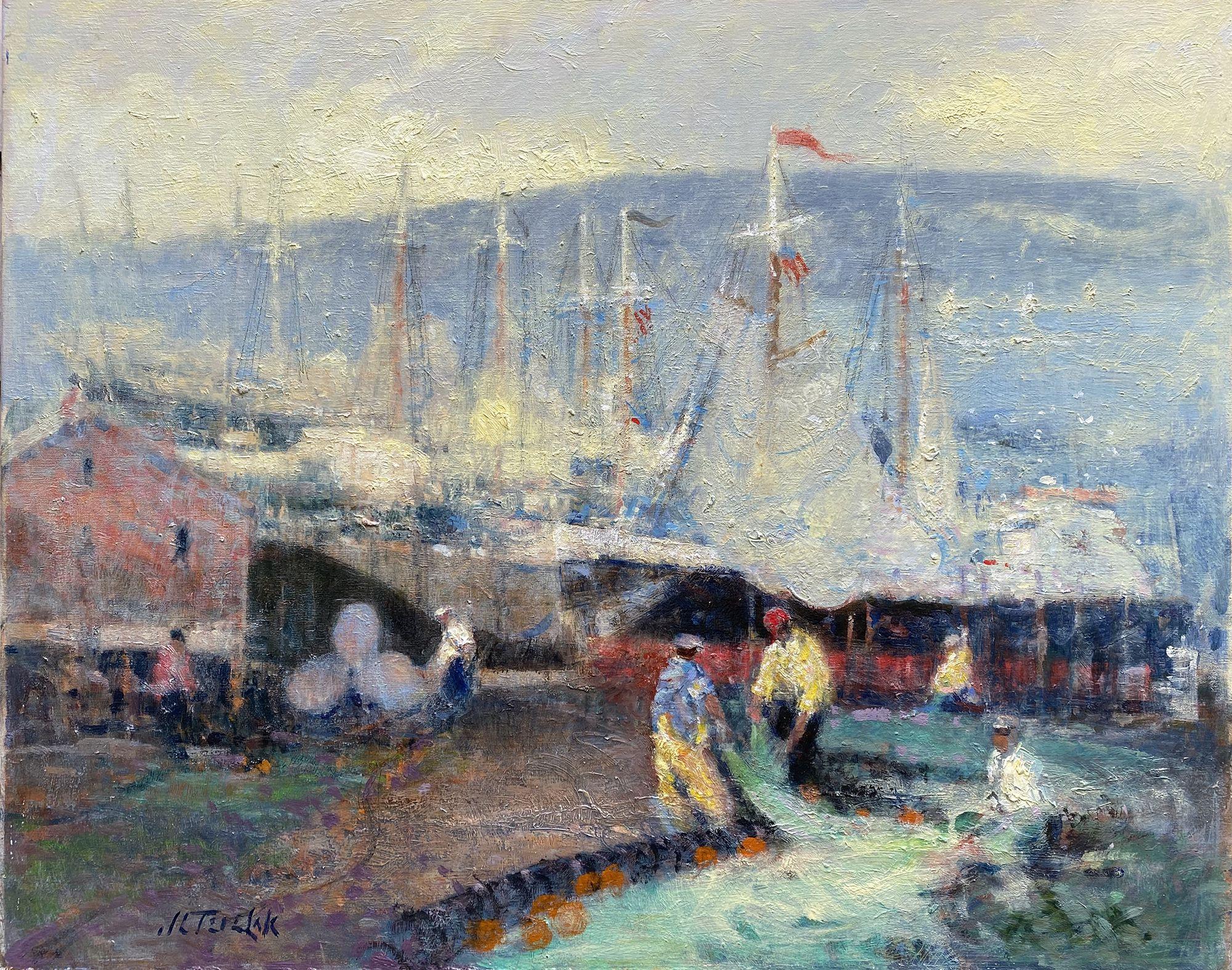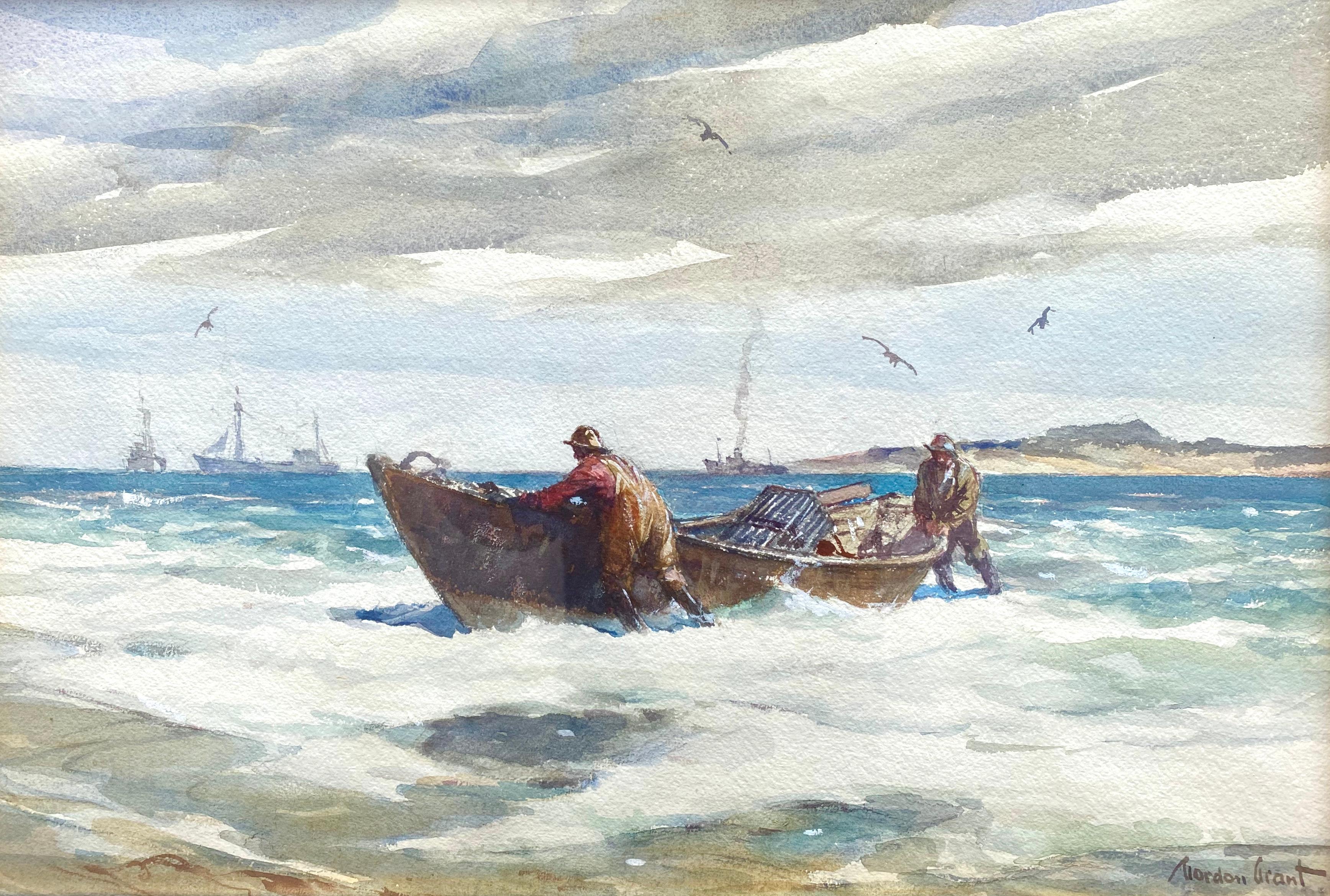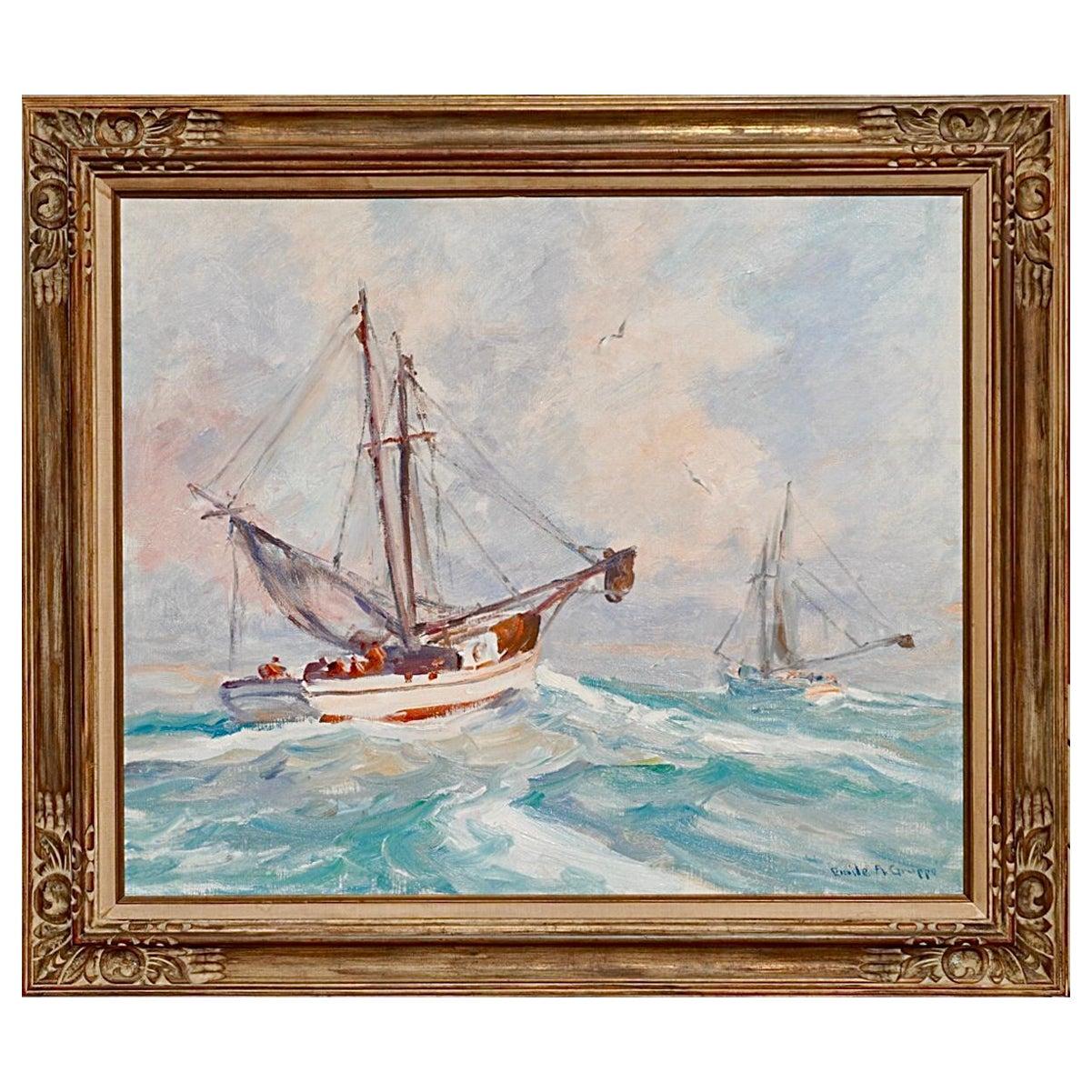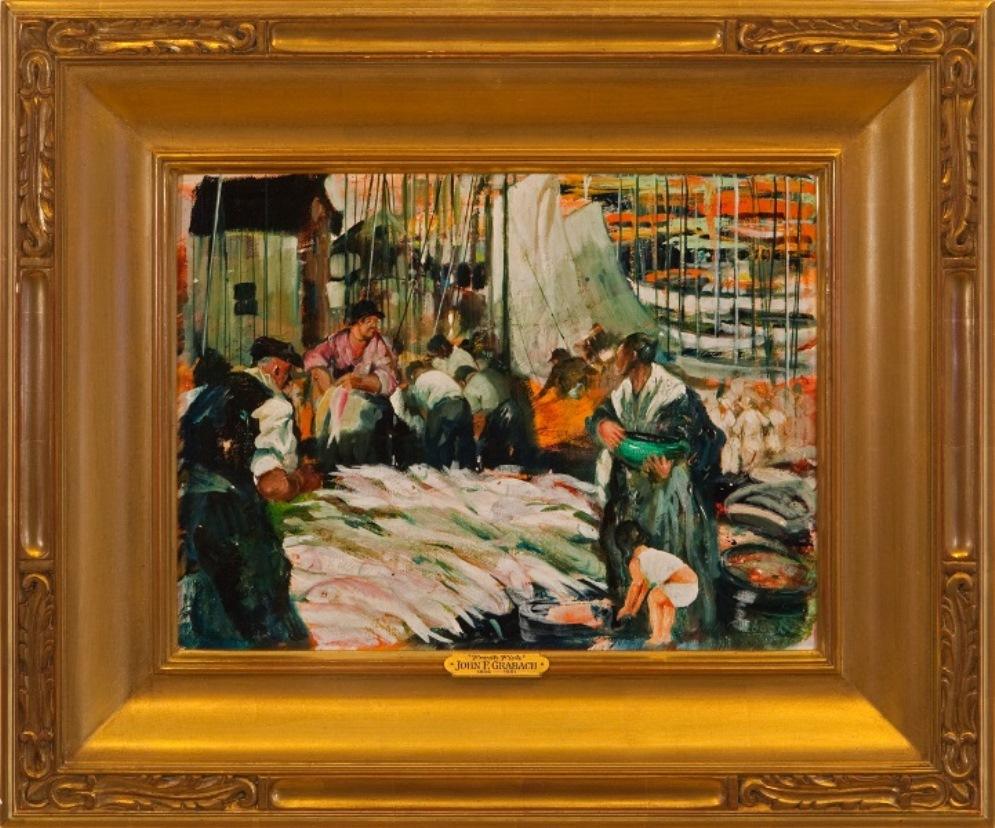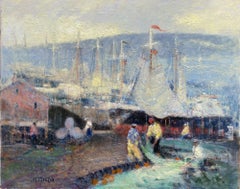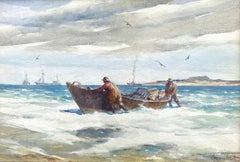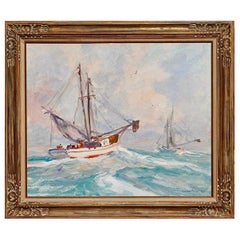Items Similar to Lobster Fishermen
Want more images or videos?
Request additional images or videos from the seller
1 of 13
Claude Curry BohmLobster Fishermenc.1945
c.1945
$6,200
£4,703.70
€5,393.06
CA$8,832.27
A$9,585.19
CHF 5,043.31
MX$116,460.27
NOK 63,141.34
SEK 59,453.32
DKK 40,267.57
About the Item
This artwork titled "Lobster Fishermen" c.1945, is an oil painting on canvas by renown American impressionist artist Claude Curry Bohm, 1894-1971. It is signed at the lower left corner by the artist. The canvas size is 20 x 24 inches, framed size is 26.25 x 30.25 inches. Framed in a new wooden gold leaf plein air style frame. It is in excellent condition, it has been recently revarnish and new keys have been added to the canvas stretcher. Please note the the dark line on the top and left side of the painting are only the shadow, it is not a part of this artwork.
About the artist:
Claude Curry Bohm, a photographer, painter, and printmaker whose artistic career spanned five decades, was an integral part of the Chicago art scene in the 1920s and a very prominent part of the second generation of the Brown County, Indiana art colony from his first visit in 1920 until his death, serving as a charter member of the Brown County Art Gallery Association and helping to transform “Brown County into one of the nation’s outstanding art colonies.”
The short, blonde-haired, gray-eyed Curry inherited some of his penchant for paints from his father Robert W. Bohm, a noted portrait, mural, and scenery painter whose family hailed from Louisiana where he was born in 1868 in New Orleans. Between 1886 and 1900, the elder Bohm was associated with Robert L. Struve as a stage set painter for New Orleans theatres such as the St. Charles Theatre and the Academy of Music and for musical venues in Mobile, Alabama.
In addition, they decorated floats and other artwork for carnival parades, including Mardi Gras. Bohm’s mother, Pauline Ogier (sometimes Oger), was born in either 1874 or 1878 in Louisville, Kentucky where her parents had settled after emigrating from France; her father was French, her mother Swiss. How and where Bohm’s parents met has yet to be established but they married around 1894, when she was either twenty or sixteen years old and he was twenty-six; Curry was born soon thereafter. Bohm’s birth has been recorded as taking place in Nashville, Tennessee on October 19, 1894, which would have been two days before his maternal grandfather, Claud Ogier, was buried in Louisville, Kentucky.
According to the 1900 United States Census, Bohm was born in August 1895 in New Orleans, Louisiana. Curry was raised in New Orleans for the first several years of his life in a home on Mandeville Street with a studio for his father near Washington Square not far from the French Quarter, in the 2nd Precinct, 8th Ward, Orleans Parish, New Orleans. Here he watched his father paint and, as he recalled later in life, had his own first adventures with paint and brush.
After the early death of his father at the age of 32 in 1901, a “readjustment of the family affairs became necessary and Curry was brought to Louisville” where his mother had family. He attended primary and secondary school in the city, living there for at least fifteen years. In 1913, eighteen-year-old Curry met fifteen-year-old Lillian Harrington at a New Year’s Eve party and just over seven months later the two eloped, fabricating facts on their marriage license in Clark County, Indiana to be wed. This appears to be when and how Curry Bohm became Claud (Claude) Curry Bohm, adopting his first name from his maternal grandfather. At the time of their marriage, Curry listed his occupation as cable splicer; he was eventually employed as a pressman for Fetters printing house in Louisville and he continued in this trade after the couple moved to Chicago around 1916.
Shortly after settling in Chicago and finding employment at the Lincoln Printing Company, the Bohms relocated for a year to Buffalo, New York, where Curry’s mother was living; Lillian was concerned about the draft. During this visit, or a previous one, Curry visited the Albright Art Gallery, now the Albright-Knox Art Gallery in Buffalo and either here, or at another venue, he saw an exhibition of pictorial photography. This experience inspired him to take up the camera, an art which he practiced for several years after the couple returned to the Windy City.
From the late 1910s to 1932 the Bohms lived and worked primarily in Chicago and Curry became a prominent part of the city’s artistic community. During these years Bohm worked for various printing companies including the Lincoln Printing Company and W. P. Dunn Company and he and Lillian lived in the Bucktown and Ravenswood neighborhoods. Though his work week must have been quite demanding, Bohm found time to indulge his artistic interests and was drawn to painting and photography.
It does not appear that Bohm was a formal student at the Art Institute of Chicago or the National Academy of Design in New York as some reports have indicated. From 1922 to at least 1928 Bohm belonged to the Chicago Business Mens Art Club, an organization of non-professional artists founded by Elbert G. Drew and Erwin S. Barrie, among others. The club was “strictly an amateur organization” open to “men thirty years or over who are not following art as a livelihood and are seeking more art knowledge.” The objective of the group was “to encourage the study and practice of painting and the kindred arts among its members and to co-operate with societies aiming to broaden the appreciation of art in our city and elsewhere.” Monthly meetings were held where members received criticisms from professional artists and there was also weekly evening instruction from Karl A. Buehr and Edward J. Timmons with some members, like Bohm, taking outdoor sketching classes from the latter as well. Eventually the Art Institute of Chicago supplied the group with “a class room and lockers, a meeting place and the use of the library.” The club held occasional exhibitions, had summer cottages for outdoor work near local lakes and rivers, and eventually had its own club rooms and studio.
Bohm was also active in the Chicago Camera Club from at least 1922 when he exhibited with the group at the Art Institute of Chicago, to around 1926; he served as secretary of the group for the 1925-26 season. In 1926, Bohm became a member of the Palette & Chisel Club (later named the Palette and Chisel Academy of Fine Arts) and remained a member for decades. He had a studio at the club for two years and exhibited at the clubhouse frequently, winning a gold medal in 1931.
Bohm’s affiliation with Indiana began around 1920 when he first visited the Peaceful Valley of Brown County. He exhibited at the Hoosier Art Gallery in Chicago and showed regularly at the Hoosier Salon in both Chicago and Indianapolis from 1928 until his death. Over the years Bohm won numerous awards from the Hoosier Salon including the Edward Rector Memorial, the Lawrence A. Downs Prize, Daughters of Indiana of Chicago Award, and the Summer Landscape Prize. He also won prizes from the Indiana Artists’ Club and the Brown County Art Gallery.
After visiting Nashville annually for several years, the Bohms moved there in 1932 and eventually became permanent residents. Bohm was a charter member of the Brown County Art Gallery Association and also served as president, vice-president, and director of the Brown County Art Guild. During his years in Nashville, Bohm also was a mentor and teacher to many aspiring painters. Bohm exhibited regularly throughout lifetime at the Palette & Chisel Club, the Hoosier Salon and various galleries in Illinois, the Hoosier Salon, Indiana Artists’ Club, Brown County Artists Guild, and galleries in Indiana, at the North Shore Art Association and Rockport Art Association in Massachusetts, and elsewhere. His most prestigious accolade came from the selection of his painting The Grey Blanket to represent the state of Indiana in the show of Contemporary Art of the United States from the collection of International Business Machines at the Golden Gate International Exposition in San Francisco in 1940. Claud(e) Curry Bohm died in Nashville, Indiana on November 18, 1971.
Selected museums and galleries:
Indianapolis Museum of Art
Indiana State Museum
Illinois State Museum
Brauer Museum of Art
Swope Art Museum
Eskenazi Museum of Art, Indiana University
Evansville Museum
Figge Art Museum
Brown County Art Gallery
Brown County Art Guild
Tri Kappa Art Collection at Rose-Hulman Institute of Technology
Indiana Memorial Union Art Collecti
Art Institute of Chicago
Corcoran Gallery of Art
Smithsonian American Art Museum
Indianapolis Museum of Art
Figge Art Museum
Illinois State Museum
Evansville Museum
Brown County Art Gallery
- Creator:Claude Curry Bohm (1894 - 1971, American)
- Creation Year:c.1945
- Dimensions:Height: 26.25 in (66.68 cm)Width: 30.25 in (76.84 cm)Depth: 1.25 in (3.18 cm)
- Medium:
- Movement & Style:
- Period:
- Condition:
- Gallery Location:San Francisco, CA
- Reference Number:Seller: bohm/lob/fis/011stDibs: LU666314388012
About the Seller
5.0
Platinum Seller
Premium sellers with a 4.7+ rating and 24-hour response times
Established in 1999
1stDibs seller since 2017
844 sales on 1stDibs
Typical response time: 1 hour
- ShippingRetrieving quote...Shipping from: San Francisco, CA
- Return Policy
Authenticity Guarantee
In the unlikely event there’s an issue with an item’s authenticity, contact us within 1 year for a full refund. DetailsMoney-Back Guarantee
If your item is not as described, is damaged in transit, or does not arrive, contact us within 7 days for a full refund. Details24-Hour Cancellation
You have a 24-hour grace period in which to reconsider your purchase, with no questions asked.Vetted Professional Sellers
Our world-class sellers must adhere to strict standards for service and quality, maintaining the integrity of our listings.Price-Match Guarantee
If you find that a seller listed the same item for a lower price elsewhere, we’ll match it.Trusted Global Delivery
Our best-in-class carrier network provides specialized shipping options worldwide, including custom delivery.More From This Seller
View AllFishing Boat
Located in San Francisco, CA
This artwork "Fishing Boat" c. 1950 is a watercolor on paper by California artist Eleanor M. Wilkevich, 1908-1969. It is signed at the lower left corner by the artist. The artwork size is 16 x 19.5 inches, framed size is 24.25 x 27.5 inches. The artwork is in excellent condition, the frame is damaged and will be replaced by a new black frame before shipping. This will bring the over all condition to excellent.
About the artist:
Born in New York City on Aug. 2, 1908. Wilkevich studied at the Art Students League and Grand Central Art School in New York City. By the late 1930s she had settled in San Diego where she taught painting. She died there on May 6, 1969.
Member: San Diego Art Guild; La Jolla Art...
Category
Mid-20th Century American Impressionist Figurative Drawings and Watercolors
Materials
Watercolor
Pecheurs en Mer (Fishermen at Sea)
Located in San Francisco, CA
This artwork "Pecheurs en Mer (Fishermen at Sea) c.1920 is an oil painting on canvas by noted French artist Rene Lienard De Saint Delis, 1877-1958. It is signed at the lower left corner by the artist. The canvas size is 23,5 x 28.5 inches, framed size is 33.5 x 38.85 inches. Framed in a new wooden gold frame with fabric liner. It is in good condition, Has minor stable non open cracks in the paint due to age, visible under raking light, see pictures 7-8-9
About the artist:
Born in 1876 in Saint-Omer, Eugène René is the second of four children of Antoine Albert Liénard of Saint-Delis (1840-1881), officer of the 5 th regiment of dragons and his wife Antoinette Emma Houet (1847 -1920). The birth of our artist is followed by that of his brother Henri (1878-1949), also a painter . The death of the illnesses of Captain Liénard de Saint-Delis led Emma to leave the Pas-de-Calais in 1881 to move to Le Havre with her four children.
After high school François-I of Le Havre where another student, Émile Othon Friesz , is his best friend, René de Saint-Delis attended successively the Municipal School of Fine Arts of Le Havre where, with his classmates, besides his brother Henri and Othon Friesz, others who will also become his friends ( Georges Braque , Raoul Dufy , Raimond Lecourt ), he follows the courses of Charles Lhuillier (a "great admirer of Boudin " at the same time as "he places the drawing first and foremost, forbidding his pupils to use color , and the Académie Julian in Paris, where from 1900 to 1904 he was a pupil of William Bouguereau . On January 29, 1906, Le Havre created the Circle of Modern Art, which consisted of artists (among them, René and Henri de Saint-Delis, their aforementioned friends, but also Gaston Prunier...
Category
Early 20th Century Impressionist Figurative Paintings
Materials
Oil
Landscape with people fishing
By Morris Katz
Located in San Francisco, CA
This artwork "Landscape with People Fishing" 1978, is an oil painting on hard board by Polish/American artist Morris Katz, 1932-2010. It is signed and dated at the lower right corner by the artist. The artwork (Hard Board) size is 20 x 24 inches, framed size is 28 x 31.75 inches. Framed in original wooden gold frame, with fabric liner and gold trim. The artwork is in excellent condition, the frame is in very good condition.
About the artist:
On May 9th, 1988, the New York artist set a new world record by painting a 12- by 16-inch canvas of a child in the snow in just half a minute. (It took an additional eight seconds to frame it.) And that wasn’t the only distinction granted to Katz by the Guinness Book of World Records—his name appeared alongside Pablo Picasso’s under the heading for “Most Prolific Painters.” The Spanish master is estimated to have completed some 13,500 paintings in his life; when Katz died in 2010 at age 78, he was credited with 225,000.
Katz’s preposterously productive career began in the small Polish village where he was born in 1932. He started studying under a German painter at age 13, but following World War II he earned a diploma in carpentry instead. In 1949, at the age of 17, he travelled to the United States. It was there that he picked up a paintbrush again, while studying at the Art Students League of New York and showing in the Village. “Soon, I decided I was good enough—compared to others, excellent enough—to make my living as an artist,” he said.
It was during those years that he developed the techniques that would eventually land him in the record books. He tossed out his paintbrushes and replaced them with palette knives and toilet paper, which he used to stipple the paint. “Soon I picked up speed,” Katz said. “If you know which way you’re travelling, then you can run.” He made art in bulk, buying up canvases by the thousands and paint by the gallon. He went through some 10,000 rolls of toilet paper per year; he often wore out palette knives.
Katz branded his method as “instant art.” Charles Salzberg, writing in New York magazine in 1978, urged readers, “Think of him, if you will, as the McDonald’s of the art world”—fast, cheap, and ubiquitous.
He wore a green beret, paint-splattered pants, and a shirt emblazoned with the words “Morris Katz - World’s Most Prolific Artist.” It was a title that came with a price—he worked 18-hour days into his 60s, sometimes from his Greenwich Village studio and other times as a performer at hotels across the Catskills. He would often visit three different hotels in the same day, waking up at 7 a.m. and returning home as late as 1 a.m.
His show was as much about the painting as it was the one-liners: “These are the highlights—you can tell because they’re high up on the painting,” he might say. Audiences gobbled up the jokes and the works, often paying less than $50 for a painting. “I give them a fresh painting like a fresh bagel,” he said.
Photographer David M. Spindel first met Katz on assignment. “They’d call him mashugana—that’s the Yiddish word for a little bit crazy,” he told Artsy. The pair soon became friends, and Spindel ended up attending several of the artist’s hotel shows.
“There were a lot of people from the hotel who were sitting in the room and he set up his easel and his toilet paper and paints and knocked out paintings one after another,” Spindel said. “Just a couple of minutes for each painting, usually. If he was kibitzing with the people in the audience then it took a lot longer. He was always clowning around.”
His act was ready-made for television; he appeared on 60 Minutes, David Letterman, and Oprah, among other programs. And Katz didn’t just make instant art—he taught it as well. In 1987, the New Yorker sent a writer to attend one of his speed-painting classes at the Notre Dame School on West 79th Street. A dozen eager students watched in admiration as he whipped up a mountain landscape, asking for advice on how, exactly, to hold their toilet paper for maximum artistic effect. For those who couldn’t make it to Manhattan for a lesson, he published a book—Paint Good & Fast (1985)—with a title as straightforward as his philosophy on art.
“Life goes faster and faster,” he wrote. “The fine arts must keep pace. This art will one day be...
Category
Late 20th Century American Impressionist Landscape Paintings
Materials
Oil
Landscape with Fishermen
Located in San Francisco, CA
This artwork "Landscape with Fishermen" c.1970 is a palette knife oil painting on canvas by noted artist Paul Blaine Henrie, 1932-1999. It is signed at the...
Category
Late 20th Century American Impressionist Landscape Paintings
Materials
Oil
At the dock
Located in San Francisco, CA
This artwork "At the Dock" c.1980 is a watercolor on 500 Aquarelle paper by noted American artist Allen Daniel (Dan) Burt, 1930-2004. It is signed at the lower right corner by the artist. The artwork size is 21.5 x 29.5 inches, framed size is 29.5 x 37.5 inches. Custom framed in a white metal frame, with off-white matting. The artwork is in excellent condition, the frame has some minor scratches, the acrylic glass have some scratches and will be replaced by a new...
Category
Late 20th Century American Impressionist Figurative Drawings and Waterco...
Materials
Watercolor
Harbor Scene
Located in San Francisco, CA
This artwork "Harbor Scene" 1975, is a watercolor on paper by Latvian artist Paul Duskins, 1928-1996. It is signed and dated at the lower right corner by the artist. The artwork size...
Category
Late 20th Century Impressionist Figurative Drawings and Watercolors
Materials
Watercolor
You May Also Like
Harbor Scene with Boats & Fishermen
Located in Milford, NH
A fine impressionist oil painting of a New England harbor scene with boats and fishermen by American artist Harry Aiken Vincent (1867-1933). Vincent was born in Chicago, Illinois, an...
Category
Early 20th Century American Impressionist Landscape Paintings
Materials
Canvas, Oil
Fishermen
By John Terelak
Located in Greenwich, CT
American, b. 1942
John Charles Terelak is recognized as one of America's finest living impressionists. Born in Boston, Massachusetts, he received formal art instruction at the Vespe...
Category
2010s American Impressionist Figurative Paintings
Materials
Canvas, Oil
“The Lobstermen”
By Gordon Grant
Located in Southampton, NY
Beautiful original watercolor and gouache on archival paper by the famous American marine artist, Gordon Grant. The artwork depicts two rugged lobstermen bringing their catch ashore...
Category
1930s American Realist Landscape Drawings and Watercolors
Materials
Watercolor, Gouache, Archival Paper
Emile Albert Gruppe Fishing Boats Ex- Christies 30x36
By Emile Albert Gruppe
Located in Dallas, TX
Emile Gruppé (1896-1978)
Fishing Boats
A large and commanding marine sailboat fishing boat scene with blue waters and blue skies. Birds are flying up above and fish swimming below ...
Category
1940s American Impressionist Paintings
Materials
Paint
"Fresh Fish"
By John R. Grabach
Located in Lambertville, NJ
Jim’s of Lambertville is proud to offer this artwork by:
John R. Grabach (1886 - 1981)
John Grabach was a highly regarded New Jersey artist, teacher, and author of the classic text...
Category
1930s American Impressionist Landscape Paintings
Materials
Canvas, Oil
Gloucester P-Town Pyle School Painting Henry J Peck - Portugese Fisherman
Located in Exton, PA
New England coastal scene painting by Henry Jarvis Peck. The artist attended the Rhode Island School of Design, studied with George Loftus Noyes, and moved to Wilmington Delaware in ...
Category
Early 20th Century American Realist Figurative Paintings
Materials
Oil
More Ways To Browse
Lobster Art
Rockport Massachusetts
Mardi Gras
1900s Oil On Canvas Portrait
Vintage Camera Club
Brown County Art
New Orleans French Quarter Painting
Lobster Painting
Vintage Mardi Gras
Mardi Gras Retro
Artwork Of New Orleans French Quarter
Plein Air Gold Frame
W Clark Mid Century Painting
Brown County Indiana Art
Hoosier Art
Vintage Palestinian
Wrestlers Painting
Wrestling Painting
